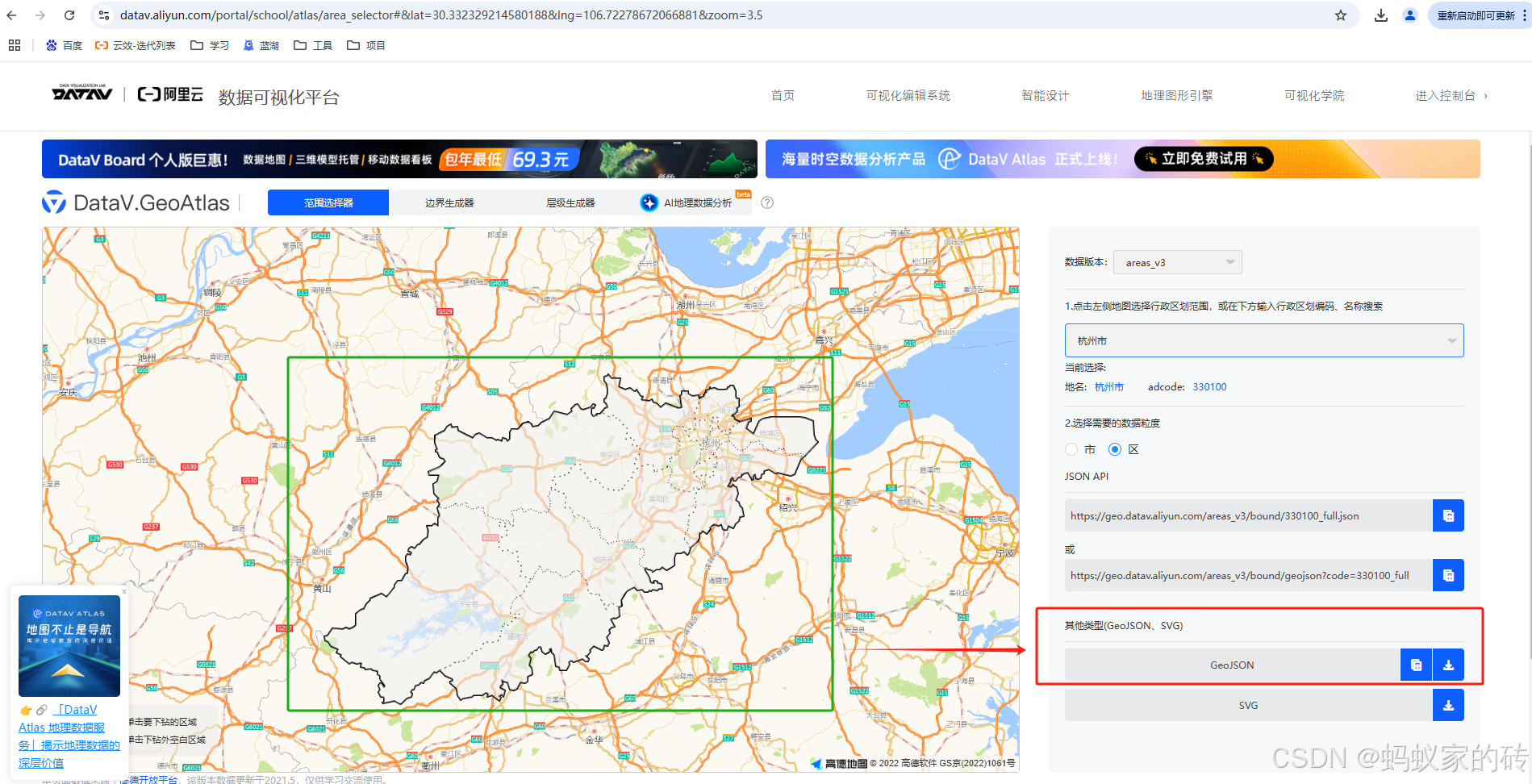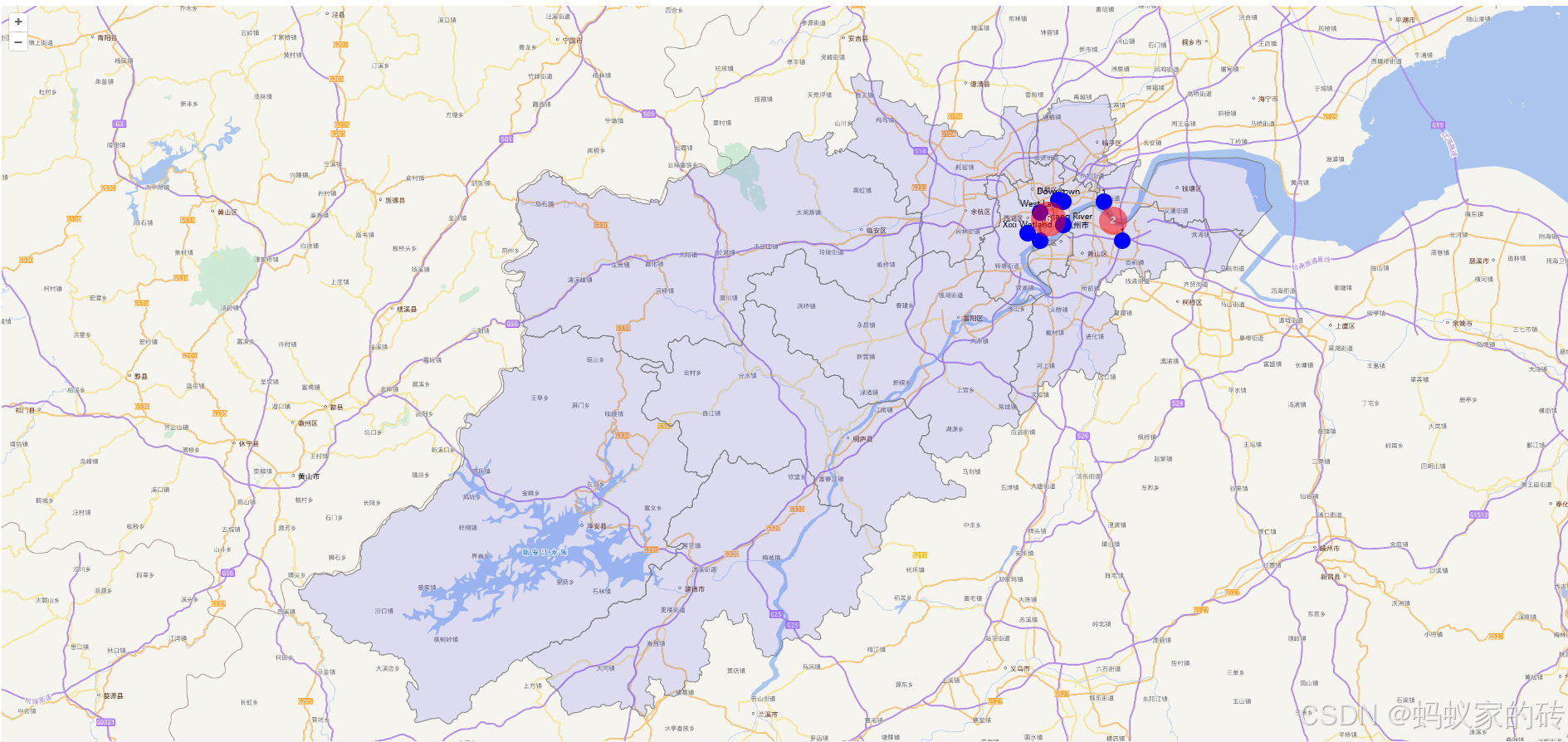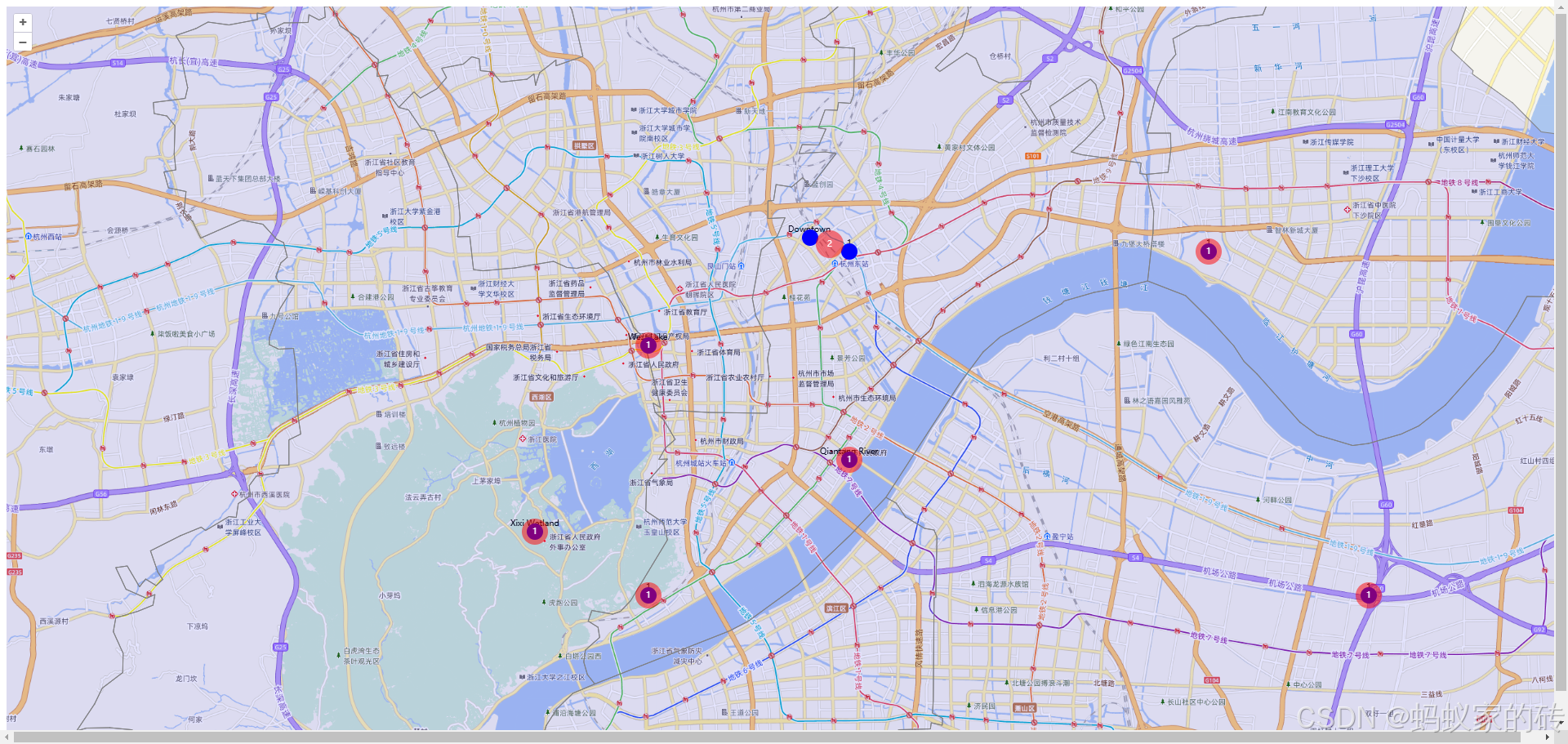功能说明
-
杭州市边界:通过加载 GeoJSON 文件显示杭州市的边界。
-
自定义地图底图:通过结合天地图实现自定义底图
-
坐标点位:在地图上显示一些固定的坐标点。
-
点位聚合:当多个点位距离较近时,会自动聚合成一个点,并显示聚合点中的点位数量。
-
点位散发:点击聚合点时,会弹出一个提示框,显示聚合点中包含的所有点位名称。
1. 引入 OpenLayers 库
在 HTML 文件中引入 OpenLayers 库。官网:OpenLayers - Welcome
<!DOCTYPE html>
<html lang="en">
<head>
<meta charset="UTF-8">
<meta name="viewport" content="width=device-width, initial-scale=1.0">
<title>OpenLayers Map with Hangzhou Boundary</title>
<link rel="stylesheet" href="https://cdn.jsdelivr.net/npm/[email protected]/ol.css">
<style>
#map {
width: 100%;
height: 600px;
}
</style>
</head>
<body>
<div id="map"></div>
<script src="https://cdn.jsdelivr.net/npm/[email protected]/dist/ol.js"></script>
<script src="main.js"></script>
</body>
</html>2. 创建地图并添加杭州市边界
编写 JavaScript 代码来创建地图并添加杭州市边界。
2.1 准备杭州市边界的 GeoJSON 数据
你需要准备一个包含杭州市边界的 GeoJSON 文件。可以从公开的地理数据源(如 Natural Earth 或 GADM)获取杭州市的边界数据。或者DataV.GeoAtlas地理小工具系列获取(记得把文件格式化)确保它与 HTML 文件在同一目录下
2.2 添加杭州市边界和坐标点
// 创建地图
const map = new ol.Map({
target: 'map',
layers: [
new ol.layer.Tile({
source: new ol.source.OSM() // 使用 OpenStreetMap 作为底图
})
],
view: new ol.View({
center: ol.proj.fromLonLat([120.1551, 30.2741]), // 杭州市的中心坐标
zoom: 9
})
});
// 添加杭州市边界
const hangzhouBoundary = new ol.layer.Vector({
source: new ol.source.Vector({
url: 'hangzhou-boundary.geojson', // 杭州市边界的 GeoJSON 文件
format: new ol.format.GeoJSON()
}),
style: new ol.style.Style({
stroke: new ol.style.Stroke({
color: 'blue',
width: 2
}),
fill: new ol.style.Fill({
color: 'rgba(0, 0, 255, 0.1)' // 边界填充颜色
})
})
});
map.addLayer(hangzhouBoundary);
// 添加一些坐标点位
const points = [
{ lon: 120.1551, lat: 30.2741, name: 'West Lake' },
{ lon: 120.2108, lat: 30.2466, name: 'Qiantang River' },
{ lon: 120.1236, lat: 30.2295, name: 'Xixi Wetland' },
{ lon: 120.2000, lat: 30.3000, name: 'Downtown' },
// 添加更多点位...
];
const pointFeatures = points.map(point => {
const feature = new ol.Feature({
geometry: new ol.geom.Point(ol.proj.fromLonLat([point.lon, point.lat]))
});
feature.set('name', point.name);
return feature;
});
const pointSource = new ol.source.Vector({
features: pointFeatures
});
const pointLayer = new ol.layer.Vector({
source: pointSource,
style: new ol.style.Style({
image: new ol.style.Circle({
radius: 5,
fill: new ol.style.Fill({
color: 'red'
})
})
})
});
map.addLayer(pointLayer);
// 添加点位聚合功能
const clusterSource = new ol.source.Cluster({
distance: 40, // 聚合距离
source: pointSource
});
const clusterLayer = new ol.layer.Vector({
source: clusterSource,
style: function(feature) {
const size = feature.get('features').length;
return new ol.style.Style({
image: new ol.style.Circle({
radius: 10 + Math.min(size, 10), // 根据点位数量调整聚合点大小
fill: new ol.style.Fill({
color: 'rgba(255, 0, 0, 0.5)'
})
}),
text: new ol.style.Text({
text: size.toString(), // 显示聚合点数量
fill: new ol.style.Fill({
color: '#fff'
})
})
});
}
});
map.addLayer(clusterLayer);
// 添加点位的散发功能
map.on('click', function(event) {
const features = map.getFeaturesAtPixel(event.pixel);
if (features.length > 0) {
const feature = features[0];
if (feature.get('features')) {
// 如果是聚合点,展开显示其中的单个点位
const originalFeatures = feature.get('features');
alert(`聚合点包含以下点位:\n${
originalFeatures.map(f => f.get('name')).join('\n')
}`);
} else {
// 如果是单个点位,显示点位名称
alert(`点位名称:${feature.get('name')}`);
}
}
});3.结合天地图
如果你想使用 天地图 作为底图,而不是 OpenStreetMap,可以通过加载天地图的 WMTS 或 XYZ 服务来实现。天地图提供了多种地图服务,包括矢量地图、影像地图和注记图层等。
以下是使用天地图作为底图,并在地图上添加坐标点位的完整示例。
3.1 准备天地图信息(天地图密钥,天地图矢量地图服务 URL)
3.2 创建天地图矢量图层,
3.3 创建天地图注记图层
3.4 创建矢量图层
3.5 将点位添加到矢量图层
// 天地图密钥(请替换为你自己的密钥)
const tiandituKey = '你的天地图密钥';
// 天地图矢量地图服务 URL
const tiandituVecUrl = `https://t0.tianditu.gov.cn/vec_w/wmts?tk=${tiandituKey}`;
const tiandituCvaUrl = `https://t0.tianditu.gov.cn/cva_w/wmts?tk=${tiandituKey}`;
// 创建天地图矢量图层
const tiandituVecLayer = new ol.layer.Tile({
source: new ol.source.WMTS({
url: tiandituVecUrl,
layer: 'vec',
matrixSet: 'w',
format: 'tiles',
style: 'default',
projection: 'EPSG:3857',
tileGrid: new ol.tilegrid.WMTS({
origin: [-20037508.342789244, 20037508.342789244],
resolutions: [
156543.03392804097,
78271.51696402048,
39135.75848201024,
19567.87924100512,
9783.93962050256,
4891.96981025128,
2445.98490512564,
1222.99245256282,
611.49622628141,
305.748113140705,
152.8740565703525,
76.43702828517625,
38.21851414258813,
19.109257071294063,
9.554628535647032,
4.777314267823516,
2.388657133911758,
1.194328566955879,
0.5971642834779395
],
matrixIds: [0, 1, 2, 3, 4, 5, 6, 7, 8, 9, 10, 11, 12, 13, 14, 15, 16, 17, 18]
})
})
});
// 创建天地图注记图层
const tiandituCvaLayer = new ol.layer.Tile({
source: new ol.source.WMTS({
url: tiandituCvaUrl,
layer: 'cva',
matrixSet: 'w',
format: 'tiles',
style: 'default',
projection: 'EPSG:3857',
tileGrid: new ol.tilegrid.WMTS({
origin: [-20037508.342789244, 20037508.342789244],
resolutions: [
156543.03392804097,
78271.51696402048,
39135.75848201024,
19567.87924100512,
9783.93962050256,
4891.96981025128,
2445.98490512564,
1222.99245256282,
611.49622628141,
305.748113140705,
152.8740565703525,
76.43702828517625,
38.21851414258813,
19.109257071294063,
9.554628535647032,
4.777314267823516,
2.388657133911758,
1.194328566955879,
0.5971642834779395
],
matrixIds: [0, 1, 2, 3, 4, 5, 6, 7, 8, 9, 10, 11, 12, 13, 14, 15, 16, 17, 18]
})
})
});
// 点位数据(经纬度坐标,EPSG:4326)
const points = [
{ lon: 121.12, lat: 28.82, name: 'Point 1' },
{ lon: 121.18, lat: 28.87, name: 'Point 2' },
{ lon: 121.14, lat: 28.84, name: 'Point 3' }
];
// 创建矢量图层
const vectorLayer = new ol.layer.Vector({
source: new ol.source.Vector(),
style: new ol.style.Style({
image: new ol.style.Circle({
radius: 5,
fill: new ol.style.Fill({ color: 'red' })
}),
text: new ol.style.Text({
text: '', // 动态设置
offsetY: -10,
fill: new ol.style.Fill({ color: 'black' })
})
})
});
// 将点位添加到矢量图层
points.forEach(point => {
const pointFeature = new ol.Feature({
geometry: new ol.geom.Point(ol.proj.fromLonLat([point.lon, point.lat])) // 转换为 EPSG:3857
});
// 设置点位名称
pointFeature.set('name', point.name);
// 动态设置样式
pointFeature.setStyle(new ol.style.Style({
image: new ol.style.Circle({
radius: 5,
fill: new ol.style.Fill({ color: 'red' })
}),
text: new ol.style.Text({
text: point.name,
offsetY: -10,
fill: new ol.style.Fill({ color: 'black' })
})
}));
vectorLayer.getSource().addFeature(pointFeature);
});
// 创建地图
const map = new ol.Map({
target: 'map',
layers: [
tiandituVecLayer, // 天地图矢量地图
tiandituCvaLayer, // 天地图注记图层
vectorLayer // 点位图层
],
view: new ol.View({
center: ol.proj.fromLonLat([121.15, 28.85]), // 转换为 EPSG:3857
zoom: 10
})
});代码说明
-
天地图服务:
-
使用
WMTS服务加载天地图的矢量地图(vec_w)和注记图层(cva_w)。 -
需要提供天地图的密钥(
tk)。
-
-
点位数据:
-
点位数据使用经纬度坐标(
EPSG:4326),通过ol.proj.fromLonLat转换为EPSG:3857。
-
-
地图视图:
-
地图的中心点坐标也需要通过
ol.proj.fromLonLat转换。
-
-
矢量图层:
-
点位使用
ol.style.Circle表示,并带有名称标签。
-
注意事项
-
密钥替换:
-
将代码中的
你的天地图密钥替换为你从天地图官网获取的实际密钥。
-
-
服务限制:
-
天地图的服务可能有访问频率限制,请遵守天地图的使用条款。
-
-
其他地图服务:
-
如果需要使用天地图的影像地图,可以将
vec_w替换为img_w,cva_w替换为cia_w。
-
通过以上方法,你可以成功使用天地图作为底图,并在地图上显示正确的点位。
4. 运行代码
将上述代码保存并在浏览器中打开 index.html。你将看到一个包含杭州市边界、坐标点位以及点位聚合功能的地图。
全部代码如下:
<!DOCTYPE html>
<html lang="en">
<head>
<meta charset="UTF-8">
<meta name="viewport" content="width=device-width, initial-scale=1.0">
<title>OpenLayers Map with linHai Boundary</title>
<link rel="stylesheet" href="https://cdn.jsdelivr.net/npm/[email protected]/ol.css">
<style>
#map {
width: 100vw;
height: 100vh;
}
</style>
</head>
<body>
<div id="map"></div>
<script src="https://cdn.jsdelivr.net/npm/[email protected]/dist/ol.js"></script>
<script src="main.js"></script>
<script>
// 自定义底图
const tiandituKey = 'xxxxxxxxxx';// 天地图密钥(请替换为你自己的密钥)
// 天地图矢量地图服务 URL
const tiandituVecUrl = `https://t0.tianditu.gov.cn/vec_w/wmts?tk=${tiandituKey}`;
const tiandituCvaUrl = `https://t0.tianditu.gov.cn/cva_w/wmts?tk=${tiandituKey}`;
// 添加一些坐标点位
const points = [
{ lon: 120.1551, lat: 30.2741, name: 'West Lake' },
{ lon: 120.2108, lat: 30.2466, name: 'Qiantang River' },
{ lon: 120.1236, lat: 30.2295, name: 'Xixi Wetland' },
{ lon: 120.2000, lat: 30.3000, name: 'Downtown' },
{ lon: 120.1551, lat: 30.2141, name: '1' },
{ lon: 120.2108, lat: 30.2966, name: '1' },
{ lon: 120.1236, lat: 20.2295, name: '1' },
{ lon: 120.2000, lat: 20.3000, name: '1' },
{ lon: 120.3551, lat: 30.2141, name: '1' },
{ lon: 120.3108, lat: 30.2966, name: '1' },
{ lon: 120.3236, lat: 20.2295, name: '1' },
{ lon: 120.4000, lat: 20.3000, name: '1' },
];
// 创建天地图矢量图层
const tiandituVecLayer = new ol.layer.Tile({
source: new ol.source.WMTS({
url: tiandituVecUrl,
layer: 'vec',
matrixSet: 'w',
format: 'tiles',
style: 'default',
projection: 'EPSG:3857',
tileGrid: new ol.tilegrid.WMTS({
origin: [-20037508.342789244, 20037508.342789244],
resolutions: [
//地图的元素
156543.03392804097,
78271.51696402048,
39135.75848201024,
19567.87924100512,
9783.93962050256,
4891.96981025128,
2445.98490512564,
1222.99245256282,
611.49622628141,
305.748113140705,
152.8740565703525,
76.43702828517625,
38.21851414258813,
19.109257071294063,
9.554628535647032,
4.777314267823516,
2.388657133911758,
1.194328566955879,
0.5971642834779395
],
matrixIds: [0, 1, 2, 3, 4, 5, 6, 7, 8, 9, 10, 11, 12, 13, 14, 15, 16, 17, 18]
})
})
});
// 创建天地图注记图层
const tiandituCvaLayer = new ol.layer.Tile({
source: new ol.source.WMTS({
url: tiandituCvaUrl,
layer: 'cva',
matrixSet: 'w',
format: 'tiles',
style: 'default',
projection: 'EPSG:3857',
tileGrid: new ol.tilegrid.WMTS({
origin: [-20037508.342789244, 20037508.342789244],
resolutions: [
//地图的元素
156543.03392804097,
78271.51696402048,
39135.75848201024,
19567.87924100512,
9783.93962050256,
4891.96981025128,
2445.98490512564,
1222.99245256282,
611.49622628141,
305.748113140705,
152.8740565703525,
76.43702828517625,
38.21851414258813,
19.109257071294063,
9.554628535647032,
4.777314267823516,
2.388657133911758,
1.194328566955879,
0.5971642834779395
],
matrixIds: [0, 1, 2, 3, 4, 5, 6, 7, 8, 9, 10, 11, 12, 13, 14, 15, 16, 17, 18]
})
})
});
// 创建矢量图层
const vectorLayer = new ol.layer.Vector({
source: new ol.source.Vector(),
style: new ol.style.Style({
image: new ol.style.Circle({
radius: 5,
fill: new ol.style.Fill({ color: 'red' })
}),
text: new ol.style.Text({
text: '', // 动态设置
offsetY: -10,
fill: new ol.style.Fill({ color: 'black' })
})
})
});
// 将点位添加到矢量图层
points.forEach(point => {
const pointFeature = new ol.Feature({
geometry: new ol.geom.Point(ol.proj.fromLonLat([point.lon, point.lat])) // 转换为 EPSG:3857
});
// 设置点位名称
pointFeature.set('name', point.name);
// 动态设置样式
pointFeature.setStyle(new ol.style.Style({
image: new ol.style.Circle({
radius: 5,
fill: new ol.style.Fill({ color: 'red' })
}),
// 也可以自定义图片
// image: new ol.style.Icon({
// src: './assets/pointer.png',
// scale: 0.4,
// anchor: [59.5, 119], // 锚点位置 [x, y],单位为像素,重要!!!否则放大缩小会错位
// anchorXUnits: 'pixels', // 锚点x单位
// anchorYUnits: 'pixels', // 锚点y单位
// }),
text: new ol.style.Text({
text: point.name,
offsetY: -10,
fill: new ol.style.Fill({ color: 'black' })
})
}));
vectorLayer.getSource().addFeature(pointFeature);
});
// 创建地图
const map = new ol.Map({
target: 'map',
layers: [
tiandituVecLayer, // 天地图矢量地图
tiandituCvaLayer, // 天地图注记图层
vectorLayer // 点位图层
],
view: new ol.View({
center: ol.proj.fromLonLat([120.1551, 30.2741]), // 杭州市的中心坐标
zoom: 11,
minZoom: 6,
maxZoom: 18,
}),
showFullExtent: true,
});
// 添加杭州市边界
const hangzhouBoundary = new ol.layer.Vector({
source: new ol.source.Vector({
url: 'boundary.geojson', // 杭州市边界的 GeoJSON 文件
format: new ol.format.GeoJSON()
}),
style: new ol.style.Style({
stroke: new ol.style.Stroke({
color: 'gray',
width: 1
}),
fill: new ol.style.Fill({
color: 'rgba(0, 0, 255, 0.1)' // 边界填充颜色
})
})
});
map.addLayer(hangzhouBoundary);
const pointFeatures = points.map(point => {
const feature = new ol.Feature({
geometry: new ol.geom.Point(ol.proj.fromLonLat([point.lon, point.lat]))
});
feature.set('name', point.name);
return feature;
});
const pointSource = new ol.source.Vector({
features: pointFeatures
});
const pointLayer = new ol.layer.Vector({
source: pointSource,
style: new ol.style.Style({
image: new ol.style.Circle({
radius: 10,
fill: new ol.style.Fill({
color: 'blue'
})
})
})
});
map.addLayer(pointLayer);
// 添加点位聚合功能
const clusterSource = new ol.source.Cluster({
distance: 50, // 聚合距离
source: pointSource
});
const clusterLayer = new ol.layer.Vector({
source: clusterSource,
style: function(feature) {
const size = feature.get('features').length;
return new ol.style.Style({
image: new ol.style.Circle({
radius: 15 + Math.min(size, 15), // 根据点位数量调整聚合点大小
fill: new ol.style.Fill({
color: 'rgba(255, 0, 0, 0.5)'
})
}),
text: new ol.style.Text({
text: size.toString(), // 显示聚合点数量
fill: new ol.style.Fill({
color: '#fff'
})
})
});
}
});
map.addLayer(clusterLayer);
// 添加点位的散发功能
map.on('click', function(event) {
const features = map.getFeaturesAtPixel(event.pixel);
if (features.length > 0) {
const feature = features[0];
if (feature.get('features')) {
// 如果是聚合点,展开显示其中的单个点位
const originalFeatures = feature.get('features');
alert(`聚合点包含以下点位:\n${originalFeatures.map(f => f.get('name')).join('\n')}`);
} else {
// 如果是单个点位,显示点位名称
alert(`点位名称:${feature.get('name')}`);
}
}
});
</script>
</body>
</html>

